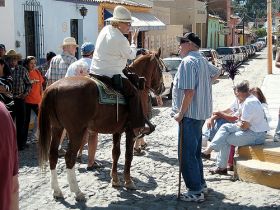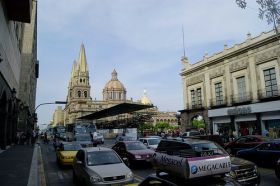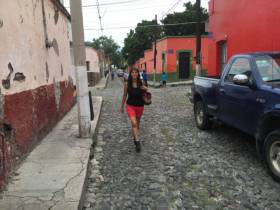How are the roads in Chapala and Ajijic, Mexico? Do I need a four-wheel drive in Chapala and Ajijic, Mexico?
Mark O'Neill
I wouldn’t go with a four-wheel drive in Ajijic and Chapala, but I wouldn’t go with an exotic sports car, either. Cobblestone streets are the norm in Ajijic and some are better maintained than others because they are individually taken care of by the local people. There is a fully paved, blacktop road that goes around the entire parameter of the Lake Chapala, which is the main road and is the main artery for communicating and bouncing back and forth but probably 95% of the...
I wouldn’t go with a four-wheel drive in Ajijic and Chapala, but I wouldn’t go with an exotic sports car, either. Cobblestone streets are the norm in Ajijic and some are better maintained than others because they are individually taken care of by the local people. There is a fully paved, blacktop road that goes around the entire parameter of the Lake Chapala, which is the main road and is the main artery for communicating and bouncing back and forth but probably 95% of the roads are cobblestone roads. They are typically very well-maintained. They can be small and narrow but you just learn to drive at 5 or 10 miles per hour, not at 50, going through the neighborhood.
The entire village of Ajijic is not more than half to three quarters of a mile wide, so if you are driving in Chapala or Ajijic, I would suggest a car or a little SUV or something simple. Once you get out of the village, the main roads are paved. There are good two and three-lane highways for the most part on the main artery. Guadalajara is only an hour’s drive away from the village with the international airport half way in between. If you go to Guadalajara, you will be driving on a regular highway. The airport is a full blown airport so in many ways it’s as nice as many US cities as far as access and drivability on the highway. It may not be quite as maintained as we expect them to be in the US but certainly, they are safe and easy to drive.
Posted July 16, 2016
Mirna Segura - Ajijic Rentals
 The roads in Chapala are better that the roads in Ajijic. The roads in Ajijic are more likely to be cobblestones. The government of Ajijic previously planned to change the cobblestone roads to concrete but the people of Ajijic did not agree because it is a small town and if you have concrete roads it tends to be hotter. Concrete roads are also not as beneficial when it rains.
The roads in Chapala are better that the roads in Ajijic. The roads in Ajijic are more likely to be cobblestones. The government of Ajijic previously planned to change the cobblestone roads to concrete but the people of Ajijic did not agree because it is a small town and if you have concrete roads it tends to be hotter. Concrete roads are also not as beneficial when it rains. However, the main road, which is called the carretera, is a paved road that...
 The roads in Chapala are better that the roads in Ajijic. The roads in Ajijic are more likely to be cobblestones. The government of Ajijic previously planned to change the cobblestone roads to concrete but the people of Ajijic did not agree because it is a small town and if you have concrete roads it tends to be hotter. Concrete roads are also not as beneficial when it rains.
The roads in Chapala are better that the roads in Ajijic. The roads in Ajijic are more likely to be cobblestones. The government of Ajijic previously planned to change the cobblestone roads to concrete but the people of Ajijic did not agree because it is a small town and if you have concrete roads it tends to be hotter. Concrete roads are also not as beneficial when it rains. However, the main road, which is called the carretera, is a paved road that goes all the way from Jocotepec, San Juan Cosala, Ajijic, and Chapala. The roads here are in Chapala and Ajijic are in good condition so you do not need a four-wheel drive.
(Cobblestone street, Lake Chapala,Mexico, pictured.)
Posted September 1, 2016
Percy Pinklebutt - Percy Pinklebutt Enteprises
 You don’t need a four-wheel drive in Chapala and Ajijic, even though, being a small town, there are a few potholes and dents in some of the roads but in general the roads are not in bad condition.
You don’t need a four-wheel drive in Chapala and Ajijic, even though, being a small town, there are a few potholes and dents in some of the roads but in general the roads are not in bad condition. The road to Guadalajara (the closest big city, about an hour away by car) can be nasty, especially in the rainy season but new cameras enforcing speed restrictions make the drive safer and the local governments are always working on maintenance in an...
 You don’t need a four-wheel drive in Chapala and Ajijic, even though, being a small town, there are a few potholes and dents in some of the roads but in general the roads are not in bad condition.
You don’t need a four-wheel drive in Chapala and Ajijic, even though, being a small town, there are a few potholes and dents in some of the roads but in general the roads are not in bad condition. The road to Guadalajara (the closest big city, about an hour away by car) can be nasty, especially in the rainy season but new cameras enforcing speed restrictions make the drive safer and the local governments are always working on maintenance in an effort to keep the roads in decent repair.
Some roads in Chapala and Ajijic are better than others. Ajijic has some cobblestone streets which add to its charm. You can really pick and choose. There are modern paved subdivisions here as well, but you do not need a four-wheel drive.
(Road to Centro Guadalajara, Mexico, pictured.)
Posted March 10, 2017
Roberto Millan - Roberto Millan Design and Construction
 You won't need a four-wheel drive vehicle for the roads in Chapala and Ajijic. It is better to use a normal small car because the streets are narrow. A wide car like a Hummer cannot go around the roads in Ajijic because there's not enough room to make the turn and you would have to go and back up. There's a gap for parking for only one car on the side to allow another car to pass through; and sometimes it's so difficult that you have to fold the mirrors inside to go through...
You won't need a four-wheel drive vehicle for the roads in Chapala and Ajijic. It is better to use a normal small car because the streets are narrow. A wide car like a Hummer cannot go around the roads in Ajijic because there's not enough room to make the turn and you would have to go and back up. There's a gap for parking for only one car on the side to allow another car to pass through; and sometimes it's so difficult that you have to fold the mirrors inside to go through... You won't need a four-wheel drive vehicle for the roads in Chapala and Ajijic. It is better to use a normal small car because the streets are narrow. A wide car like a Hummer cannot go around the roads in Ajijic because there's not enough room to make the turn and you would have to go and back up. There's a gap for parking for only one car on the side to allow another car to pass through; and sometimes it's so difficult that you have to fold the mirrors inside to go through the road.
You won't need a four-wheel drive vehicle for the roads in Chapala and Ajijic. It is better to use a normal small car because the streets are narrow. A wide car like a Hummer cannot go around the roads in Ajijic because there's not enough room to make the turn and you would have to go and back up. There's a gap for parking for only one car on the side to allow another car to pass through; and sometimes it's so difficult that you have to fold the mirrors inside to go through the road. The village roads were built for horses and "carretas" (carts) and carriages, not for cars.
(Street in Ajijic, Mexico with Jet Metier of Best Places in the World to Retire, pictured.)
Posted June 1, 2017



.png)